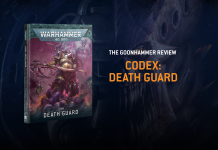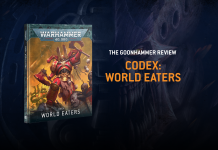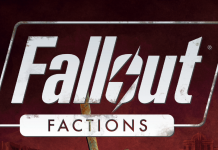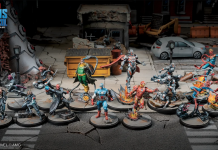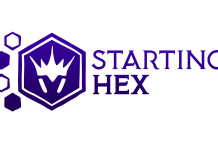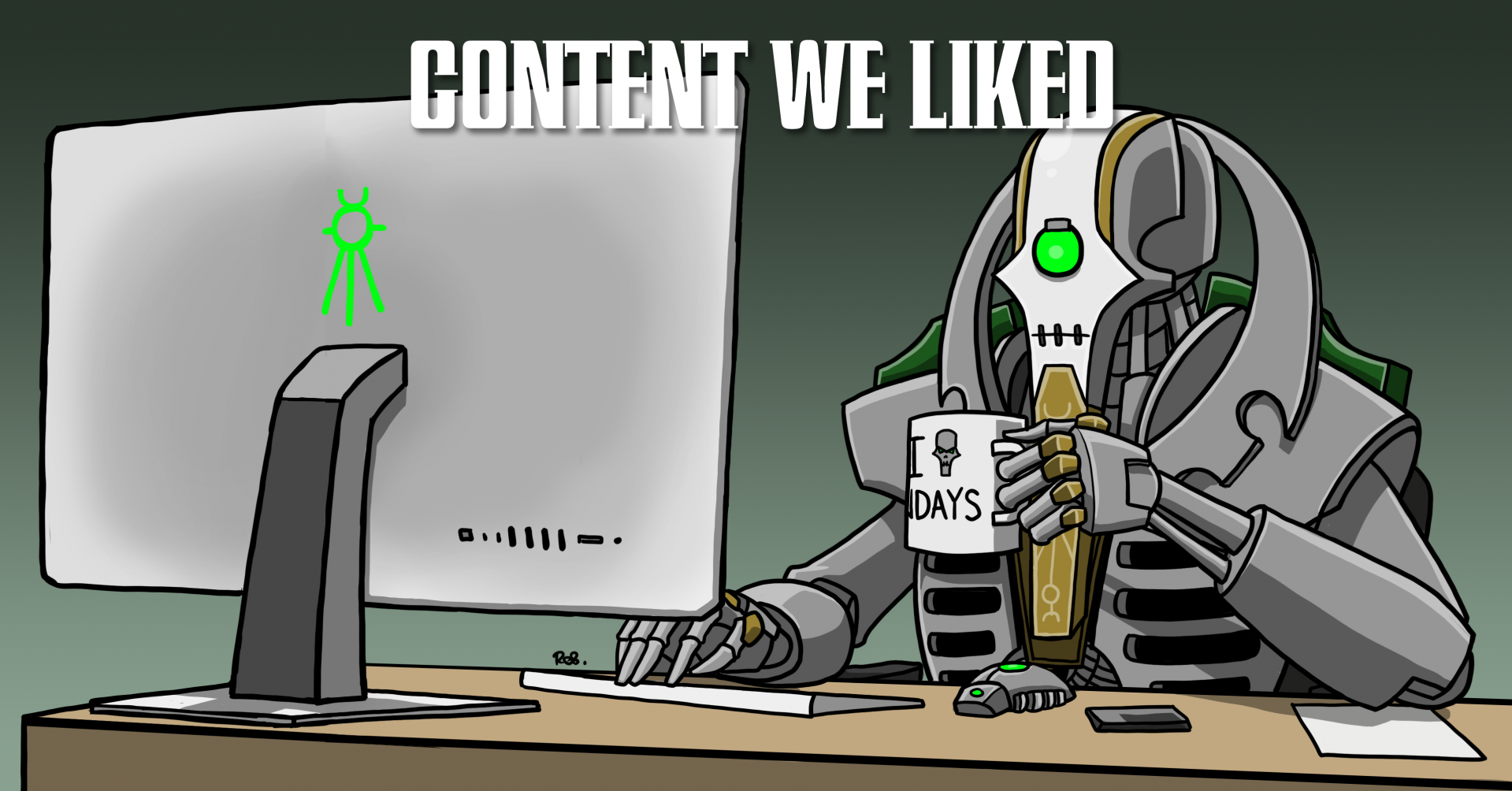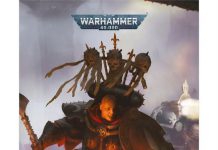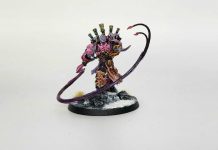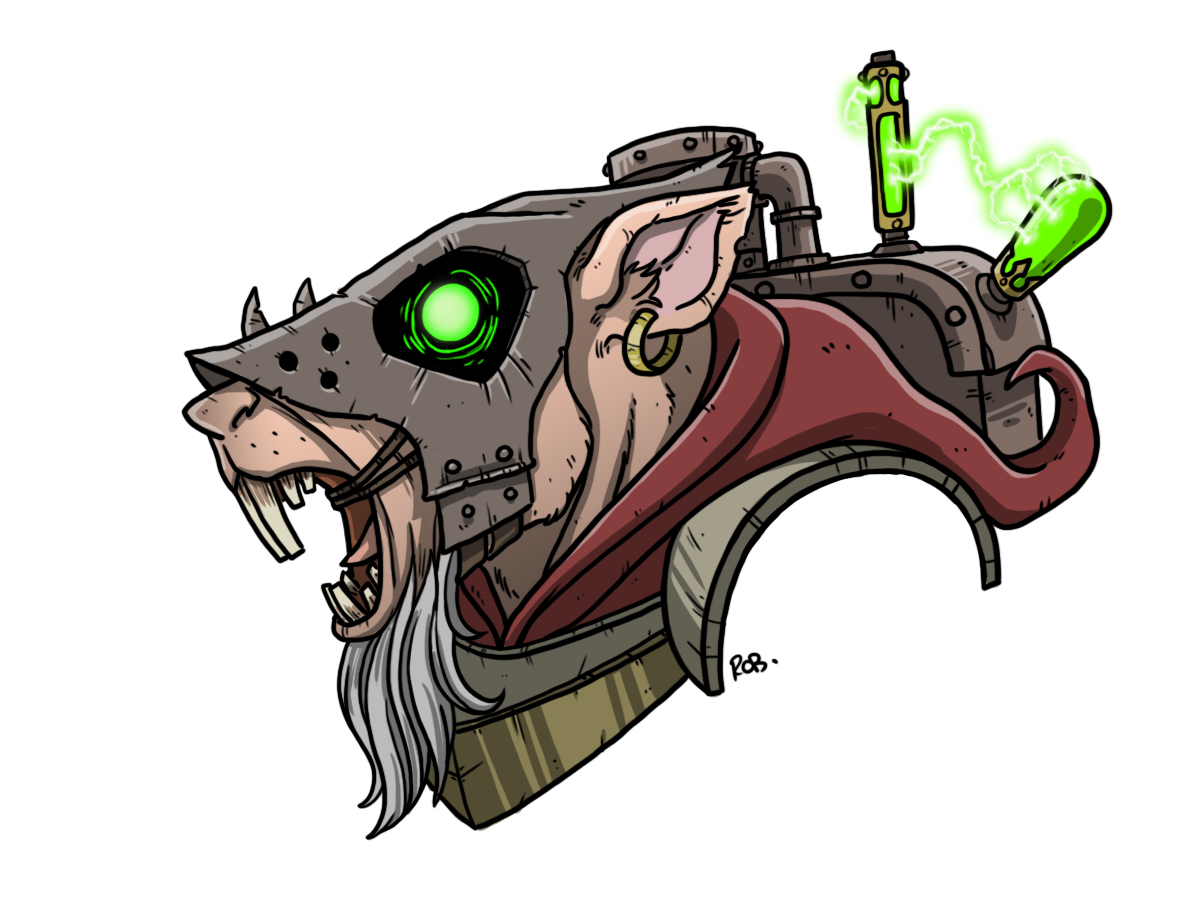Faction Overview
Why Play Skaven?
Because you like to loudly tell everyone how old the sculpts in your army are. Skaven are an army with a huge and varied range, they simply did not shed much in the transition to Age of Sigmar and as a result offer a large variety of playstyles, with a tendency towards buckets of infantry and powerful heroes.
A key theme to Skaven is that they’re a bit whacky, a bit zany, a bit unpredictable. A lot of the army has the ability to gain additional power at the risk of damaging itself quite badly so if you like to live on the edge, to gamble on the dice, this can be the army for you.
Strengths
- Powerful heroes – Skaven have a number of behemoth heroes that are powerful and competitively priced. Going full herohammer with Thanquol and Verminlords is a legitimate build.
- Massive synergy – Neatly sectioned out subfactions all have specific targeted buffs that generally provide a lot of value. Even the small heroes will provide a lot.
- Cheap bodies – The humble Clanrat is 100 points for 20 warm bodies, that’s a good deal.
- Heaps of damage – High rend, multi-damage and mortal wounds abound across the range giving powerful potential alpha strikes.
Weaknesses
- Scoring – Unless you specifically build for it, Skaven can struggle into the tighter scoring of Gallet. The castle builds often start off slow and score later in the game.
- Most units are paper – With very few exceptions, the army is very fragile and has a penchant for hurting itself into the mix. If your alpha doesn’t land, you can be losing huge amounts of your army in return.
- Bravery – A horde army with bravery ranging from 4-6 and fewer ways to mitigate battleshock in this battletome and in the overall metagame can make large portions of your army running away a real risk.
- Little ‘AoS3’ synergy – The range is old school and the tome feels old school – there’s little in the way of extra heroic actions, monstrous rampages, rally tech or tweaking to reinforcements.
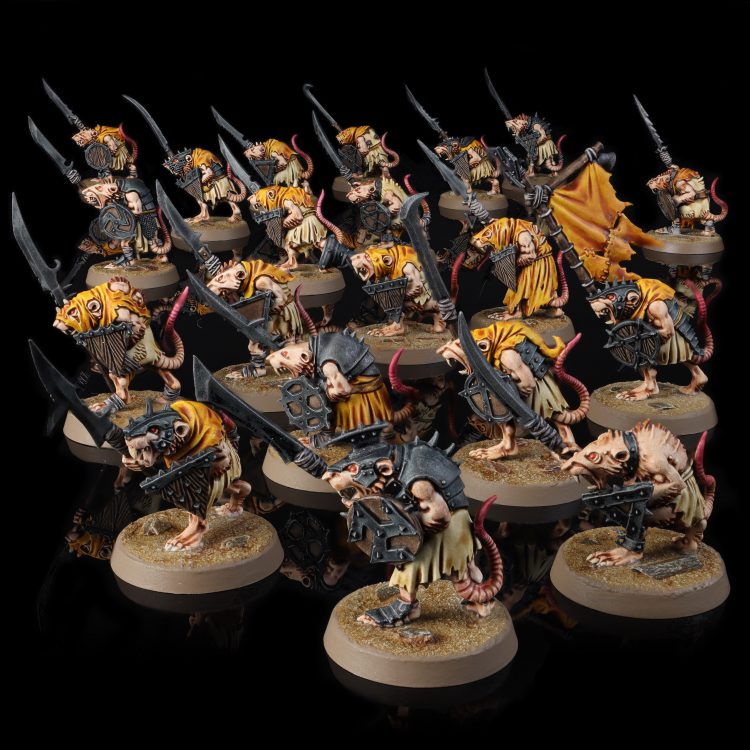
Credit: Pendulin
Competitive Rating
Mid Tier
Skaven sit firmly in Age of Sigmar’s ever-growing fat middle, with a winrate hovering in the high 40s. They’re an army that can be very reliant on specific combos going off and can be prone to rapid collapse if it starts going wrong, which will lead to game losses when they can at other times feel oppressive and powerful.
Allegiance Abilities
Battle Traits
The generic battle traits are a little light, as a great majority of what’s on offer in the Skaven allegiance is dictated by the Great Clans.
Lead from the Back
The rule you will probably forget the most, this is largely providing Look Out, Sir! but in melee, with one crucial difference. Whilst LOS! cuts off the defensive benefit at 10 wounds, Lead from the Back instead does it with the Monster keyword. This means the Screaming Bell and Plague Furnace, both models that already want to be escorted by infantry, will get the benefit of that cheeky -1 to be hit.
Scurry Away
When one of your heroes without a mount (so everything bar Thanquol, the Screaming Bell and Plague Furnace) is selected to fight, you can choose to retreat instead of pile-in and attack. Have you noticed a theme with these abilities? This will also keep your heroes alive, and can give your opponent pause for thought on order of activation if you’re involved in multiple combats.
Whilst you will normally want them fighting, do note that Verminlords are able to take advantage of this rule should you need them to.
Strength in Numbers
An interesting rule, how useful it will end up being may need to be seen once we’ve left Gallet and how GW wants to approach fighting in ranks going forward. Skaven get to add 1” to the range of their melee weapons for every 10 models in the attacking unit, to a maximum of 3”. This does still have use on massive units of Clanrats, if that’s your bag, or on melee units like Censer Bearers where you might be trying to intentionally avoid becoming a Galetian Veteran.
Even for your Gal Vets, this can still get more models fighting when the proverbial hits the fan and you find yourself in those weird combat formations that inevitably happens in AoS.
The Great Clans
Skaven are structured a little differently to the other AoS3 books released so far, the tome eschews traditional subfactions and instead gives you access to all the rules of all the Great Clans simultaneously. Every warscroll in the book is keyworded to one of the clans, so the extra battle traits for the Great Clans are gated behind having keyworded models of some type. Each of these battle traits also offers extra bonuses for having more heroes of the appropriate type.
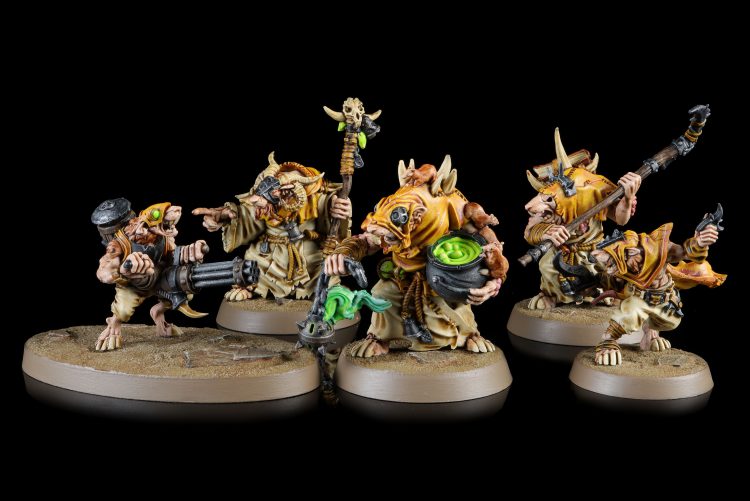
Masterclan
Skilled Manipulators
Turns friendly Skaven units into bodyguards for your non-Monster Masterclan. This is a little fiddly, the friendly unit has to be within 3” and you bounce the wound to them on a 3+. If the targeted Masterclan unit has a ward, you can opt to use this instead of the ward. Given the current competitive viability of the Screaming Bell, this is effectively extra protection for the foot Grey Seer. It’s a fine ability for keeping that one specific model alive. If the Screaming Bell gets better in the future, so does this.
Always Three Clawsteps Ahead
If you have 3 Masterclan heroes in your starting armies, you get this in addition to the Skilled Manipulators, providing you with three movement boosts to your army.
- After you make your first run roll in a phase, you can choose to use the result of that run roll for any other run rolls you make until the end of that phase.
- After you attempt your first charge in a phase, you can use the unmodified roll in place of any other charge rolls you make for that phase.
- After the first unit you pick to fight makes a pile-in move, you can make a pile-in move (but not attack) with any friendly skaven unit within 3” of an enemy unit.
These all fall under the category of kinda neat, but situational. You don’t always want to be doing loads of running or need to do loads of pile-ins, but if you do this can be good. It’s still reliant on you rolling well on that first dice roll in the phase. Grey Seers are cheap enough that getting here isn’t too much of a tax, and there are ways to unlock this ability with only two heroes. For a brief period this worked with unmodified charge rolls, which was very handy indeed to give units big charges out of teleports, but no more.
Clans Moulder
Prized Creations
This is your source of, effectively, mount traits. At the start of the first battle round you get to pick a Hell Pit Abomination in your army and give them a mutation. If you have three Master Moulders in your army, you can pick a mutation for every Hell Pit in your army (with the usual limitation of no duplicates).
Note that getting the first trait doesn’t require any Master Moulders at all, that’s great because these two warscrolls have zero interaction with each other otherwise. If you’re going full potato Moulder, then the secondary half of this rule certainly exists.
- Toughened Sinews – Hell Pit gets 16 wounds and a 4+ save. This is two more wounds and a bump to a much healthier save than the default 5+. Likely to be your pick most of the time.
- Lumbering Behemoth – Changes the Hell Pit’s move from 2d6” to 7”, and also means they always charge 7” instead of rolling. Unless you’ve cooked your dice, this works out to be a nice reliability boost. You can know that you’re guaranteed into any enemy you’re 14” away from, but equally you’re guaranteed to not be able to get into combat with anything any further away than that and redeploy can be awful for you here.
- Quivering Bulk – +1 to your rolls on the avalanche of flesh. Avalanche is an ability that does mortal wounds depending on the roll you do, starting on a 2+ and degrading to a 5+. So this is mostly helping a wounded Hell Pit push damage through. You get to reroll this dice if you charge on the base scroll, so this ends up not being that worth it.
- Accelerated Regeneration – changes the Hell Pit’s d3 wound hero phase heal to work in every hero phase, not just yours. The default defensive profile of the Hell Pit is so poor there’s a big worry here that you just lose it before this gets to proc too many times.
- Best-best Warpstone Spikes – A reroll on your 4+ spell ignore. There’ll be matchups where this is probably your choice, but not very often.
- Backup Organs – A reroll on your ability to stand back up. You’re fishing for a 5+ on this ability so with this you’re looking at pretty close to a 50/50 shot of the Hell Pit getting back up when it’s dead. Hell Pits come back with d6 wounds remaining with this ability, so you’re looking at a 5+ to come back to like and then a 3+ to come back with more wounds than you’d have gotten at baseline from Toughened Sinews.
Clans Eshin
Masters of Murder
After choosing who goes first but before the first turn actually begins you can pick an enemy hero on the battlefield and get +1 to hit and wound against them with Clans Eshin units. Another one which doesn’t require any heroes to get the basic buff, but if you do take three Eshin heroes you apply this to every enemy hero. Note that both of these bonuses apply to ranged and melee attacks.
You might recognise both of the bonuses you get here as: really good. Eshin units have had a pretty big glow-up in this tome, and can put out a great quantity of attacks. Generally you are fishing for 6s with Eshin units to get Mortal Wounds and the attacks are otherwise relatively low quality, but free hit and wound bonuses will help you to push damage through onto crucial targets.
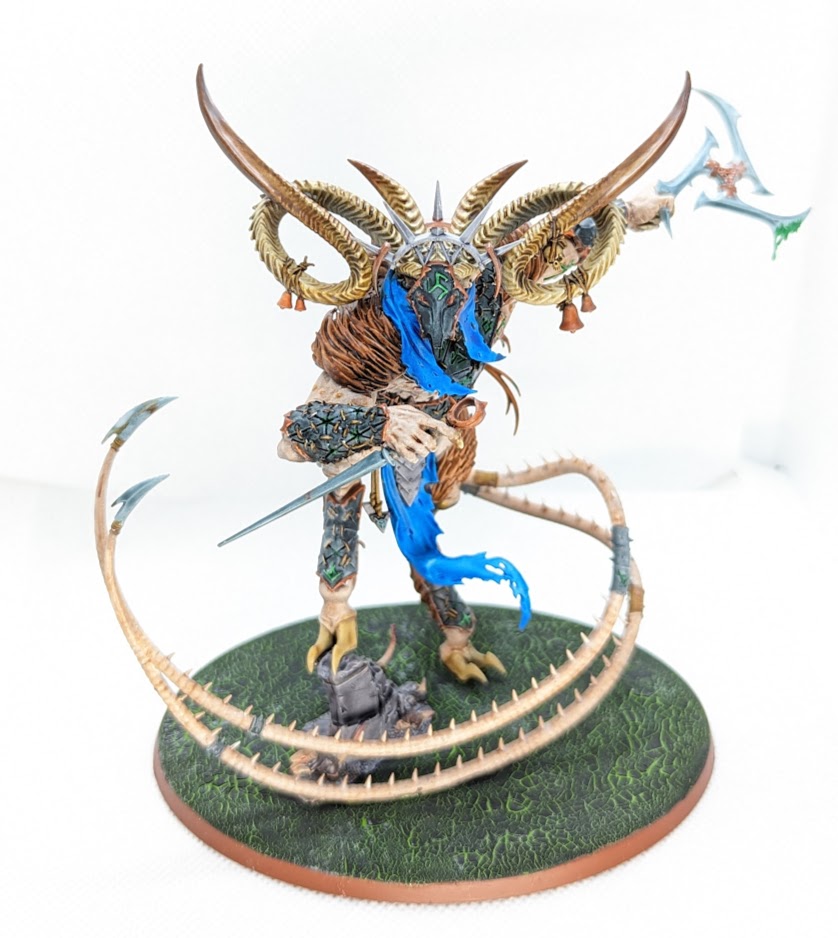
Clans Verminus
Mighty Warlords
A really bafflingly bad ability. Clawlords are already not fantastic and Mighty Warlords is trying to incentivise you to take multiples. This unlocks a heroic action you can use to apply the effects of a Skaven Command Trait they’re able to use to that Clawlord for the turn. If you have three or more Clawlords for some reason, they can all do this.
The Verminus Command Traits are not fantastic, certainly not good enough to be worth throwing points at mediocre heroes over. Without wanting to dwell on the past – this used to be an ability that just handed the traits over without having to spend a heroic action, and it used to work on the Verminlord Warbringer, and nobody ever made use of it anyway. It’s worse now, so unless you are very committed to a specific bit, it probably isn’t going to be a mechanic you chase.
Clans Skryre
Warpstone Sparks
This is an ability that does require Skryre heroes in order to activate – fortunately you are going to want them anyway. Before deployment you roll d3+3 (or d6+3 if you have three or more Skryre heroes) and get that many Warpstone Sparks. Sparks are spent one-for-one to activate specific abilities through a Skryre hero, though you can only spend one spark per phase. At the end of the phase, a hero that spends a spark takes d3 mortal wounds on the roll of a 1.
- In either hero phase you can spend a spark on a hero to reroll casting, dispelling and unbinding for them until the end of the phase. Skaven don’t have quite as many static casting bonuses as they used to, so this can be vital for pushing through spells like More-more-more Warp Power.
- At the start of the shooting phase you can pick 3 units wholly within 13” of the hero and their missile weapons get +1 damage. This is likely your bread and butter as a Skryre player, as it dramatically boosts the damage output of your Stormfiends, Acolytes and Ratling guns. It’s less good on Jezzails, though still fine, and doesn’t work at all on Warp lightning cannons.
- In the combat phase the hero itself can pick up +1 to hit and wound. These are great buffs but not on these heroes, the Arch Warlock is the best melee threat but this is really a desperation move more than anything. There isn’t a Skryre Verminlord so no cheeky combo here.
Clans Pestilens
Echoes of the Great Plagues
This is the most complicated of the Clans, and fully requires Pestilens heroes. If you roll a 6+ on your chanting roll with a Clans Pestilens priest you can pick a great plague to manifest in addition to the prayer you were originally chanting. In addition to this, whenever a Pestilens Priest is chanting a prayer you can stack +1 to the roll for every other Pestliens Priest within 13”.
Stacking bonuses to chant are already fantastic, especially if you’re attempting a prayer with a more difficult chanting value, but if you’re willing to chase it, being able to reliably get great plagues out has a lot of potential power. You can only ever manifest one great plague a turn, and can only pick each great plague once.
- The Neverplague – AKA the turn one great plague. You can reroll all chanting rolls for all Pestilens priests for the rest of the game. Yes, thank you.
- Bubonic Blightplague – Pick the nearest enemy unit within 13” and slap ‘em with 2d6 mortal wounds. If the unit is destroyed you can pick any enemy unit within 6” of the last model slain and do d6 mortal wounds to that unit. Then if that unit is destroyed you do the same and it’s d3 mortal wounds, which keeps recurring as long as you keep killing. There’s some play for your opponent with removing models and the 6” range here but to be honest even at its worst the basic effect of 2d6 mortal wounds is brutally effective enough.
- Crimsonweal Curse – Again you pick the nearest enemy unit within 13”. This time they’re infected for the rest of the battle. They take a mortal wound immediately and then at the start of each turn they take another, as does every other enemy unit within 1” of them. This is situationally OK. If there’s a big melee happening with lots of units, this could splash a good number of morals around.
- Redmaw Plague – This targets the nearest enemy hero within 13” and infects them for the rest of the battle. At the start of the combat phase, if that hero is within 3” of any enemy models and not within 3” of any of your models you can count it as a friendly model for that phase. There’s obviously a fair amount of play your opponent has with positioning to avoid this, but sometimes you are going to be able to engineer Arachaon to batter his own army and that’s hilarious.
- Undulant Scourge – Nearest enemy unit within 13” again. This is your classic horde clearer, roll a dice for each model in the target unit and do a mortal wound on a 4+. Being a horde clearer makes the nearest unit positioning a bit more difficult, but the 4+ means even tagging medium sized units will do a few mortals.
Artefacts
Whoever designed this book decided that the artefacts should be clan locked, but formatted as one massive list. Please do not do this again GW.
Masterclan
- The Gnawshard – Upgrades one of the bearer’s melee weapons, if it does any damage to a unit then that unit takes a mortal wound at the end of each turn. There’s only one Masterclan hero who can take an artefact and wants to be anywhere near melee and this effect is far too marginal to bother spending an artefact on, pass.
- Skavenbrew – Once per turn in your hero phase you can pick another Skaven unit within 3”. They take d3 mortals but gain +1 Attack on their melee weapons. Melee Skaven can be surprisingly nasty and there’s plenty of units that don’t mind taking some chip damage to massively up their attacks. This also combines very nicely with Death Frenzy to really pump up the number of times you get to swing with a unit. Note that the targeting is just keyword Skaven so if you line it up right this can be put on Verminlords, Hell-Pits, Rat Ogors, the battletome is your oyster.
- Staff of Rightful Supremacy – A very interesting artefact that you likely won’t see taken all that often but is situationally excellent. The bearer gains a 13” aura of -1 to cast for enemy wizards. Also you get a once per game auto dispel for an endless spell within 13”, but only in your hero phase (note that the dispel attempt doesn’t have to be the bearer, so you could attempt it with another hero and still trigger the artefact).
Verminus
- Shield of Distraction – Another very interesting artefact, this one makes it so that the bearer can only be picked as the target of a combat attack by one unit each phase. This is also situationally very powerful. The Verminlord Warbringer wants to be getting stuck in as early as possible and this can make it fantastic for gumming up multiple units in melee.
- Rustcursed Armour – Alternatively there is this, which hands out a very nice flat +1 save that’s always ‘on’. On top of this, you can target an enemy hero holding an artefact at the start of the combat phase and if you beat their bravery, they lose it. Heroes with artefacts that end up in combat tend to have quite high bravery so this ability is more nice to have for when you roll boxcars, but your basic effect is nice enough that this hardly matters.
- Warpstone Charm – Verminus really got the pick of the great artefacts here, going 3/3 of “I would take this”. This one is offensive as opposed to defensive, and gives the bearer a 3” aura of -1 to save rolls for enemy units. Again, the Warbringer wants to be stuck in melee and also wants to be surrounded by friendly units who can also take advantage of this. There’s a downside in that you take d3 mortal wounds if you roll a 1 at the start of your hero phase, but that’s a pretty minor downside.
Eshin
- Shadow Magnet Trinket – Up front, it’s weird to me that the assassin subfaction gets no damage boost artefacts, but here we are. Three quite techy once-per-game options. For once-per-game, these are all OK. The Shadow Magnet Trinket gets activated at the start of any combat phase and gives the bearer the strike-first effect until your next hero phase. As we will see, Deceivers like going first quite a lot.
- Farskitter Cloak – Probably the weakest option here, once-per-game you get to remove the bearer from the battlefield at the end of your movement phase and set them up again more than 9” from enemy models.
- Gnawbomb – In your hero phase you can pick a terrain feature within 6” and turn it into a gnawhole (except not becoming impassable). The timing here means you have the ability to Skitterleap into place to use this if needs be. This could probably get an article all to itself in terms of using it and the skill ceiling involved but at the most basic level you’re getting to make something into effectively arcane terrain and teleport through it. This could be game winning to pointless, depending on the situation and how you use it.
Skryre
- Vial of the Fulminator – At the start of your movement phase you can pick a Skryre warmachine and double its Move characteristic until the end of that phase, then it takes d3 mortal wounds on the roll of a 1 at the end of the phase. Skryre warmachine targeting means this is Doomwheel specific unless you have a grand desire to see a Warp Lightning Cannon move 6”. Doomwheels are fine and an 8d6” movement is extremely funny, especially as Doomwheels can run units over for damage. Is it worth your artefact slot? Probably not. But if you’re doing a mass Doomwheel thing then go hog wild, you’re already in your own world.
- The Brass Orb – Hilarious, and a classic Skaven artefact. Once per game you can hurl the Brass Orb at an enemy within 6” at the start of your hero phase. On a 3+ you remove the unit, then at the end of the turn set them up again wholly within their own territory and more than 9” from your units. The FAQ has confirmed that if there’s no legal place to play that model, it’s destroyed. An extremely funny and ignoble end to the Shadow Queen if you can pull it off. The range and the timing of this mean that pulling it off is largely within your opponent’s control (or banking on a double to engineer it), willingly entering the threat range of the Orb.
- Esoteric Warp Resonator – Skryre are blessed with one non-comedy artefact. The bearer generates an extra warpstone spark at the start of each battle round that lasts for that battle round and only they can use. Simple, effective, good.
Moulder
- Lash of Fangs – Makes your Master Moulder do d3 mortal wounds on a 6 to hit in melee. Your weapon options here are 6 or 4 attacks, so OK but by no means guaranteeing anything. It’s also on a 5 wound 5+ save buff platform, so let’s just skip right by.
- Foulhide – Gives your Master Moulder 10 wounds and they heal a wound at the start of your hero phase. It’s OK. The model still only has a 5+ save but if your battle plan relies on it being alive for whatever reason then this + Stormvermin probably keeps it alive unless your opponent really goes for it. But if they’re that important then Master Moulders are only 90 points, just take two.
- Rabid Crown – Reveals the weirdness of the Moulder sub-keywords but is actually good, a wholly within 13” aura of +1 to hit for effectively everything Moulder that isn’t a Master Moulder. Rat Ogors and Hell-Pits hit really, really hard so being able to hand out free All-Out Attacks is fantastic for them. Works on your Rat Ogor shooting too, I guess.
Pestilens
- Blade of Corruption – This could have been glorious. Upgrade a melee weapon and if the wound roll is a 6 the attack has rend -3 and damage 6. Damage six! Old Skaven players licking their lips at this and thinking of the Verminlord Corruptor’s 10 attacks were then bitterly disappointed to see the Corruptor moving to 2d6 attacks that degrade. Boo I say, boo to this. Especially given Skreech Verminking’s plaguereaper gets to have 8 attacks base.
- The Fumigatous – At the start of the combat phase pick an enemy unit within 3” and do some mortal wounds based on a die roll. 1-2 is none, 3-4 is d3, 5-6 is d6. Probably not worth it versus your other options but if you’re on a solo Pestilens gimmick then this on a Plague Furnace can give that model a pretty hefty mortal wound output in melee.
- Blistervous, the Living Cyst – Strikes-first for the bearer if they charge. If you’ve got more than one Pestilens hero then from battle round two this artefact will start bouncing between them, which is not ideal for a subfaction with a Priest who doesn’t really want to be in melee. If you’re just running a solo Corruptor then it’ll stay with them, but then why are you running a solo corruptor?
Command Traits
No Keyword
- Devious Adversary – If the general fights and is within 3” of an enemy model that hasn’t fought yet, add +2 to all of their melee weapons attacks characteristics. Ding ding ding. If you’re running a Verminlord, this is probably their command trait. +2 Attacks is a fantastic buff on their high quality attacks and the condition is easy enough to achieve. Big money on the Deceiver with its rend -3 and also on the Warbringer who has two good melee profiles, and more swings with the fist is always good.
Masterclan
- Supreme Manipulator – Gives you a reroll on the Heroic Leadership heroic action. It’s OK, command points are very nice, but you can do better than this.
- Master of Magic – How to confuse your opponent in one easy step, simply have a command trait with the same name as a generic one and a very similar but slightly different effect. A Masterclan Master of Magic (try saying that three times quickly) gets to reroll all of their casting, dispelling and unbinding rolls. Skaven have some spells with very high casting values, so this can be useful on something like a Warpseer to push their spells through whilst also providing anti-magic defence.
- Diabolical Schemer – When a model issues a command within 13” of your general then on a 5+ that command isn’t received, the command point is lost and you gain a command point. It’s a huge effect when it happens, but the model issuing the command having to be so close and the dice roll can make it difficult to use and then unlikely even when the situation occurs.
Verminus
Remember, these are what the entire Verminus allegiance ability is built around, so hopefully they’re good.
- Verminus Valour – Turns every skaven unit within 3” into a bodyguard. Very similar to the Skilled Manipulators battle trait, but doesn’t require the unit to have 3 or more models.
- Savage Overlord – A friendly unit within 3” that fails a battleshock test can instead take d3 mortal wounds and pass the test. Note that clanrats also regenerate d3 models each battleshock phase, lessening the negative impact of this.
- Powerful Alpha – Negate the first two wounds or mortal wounds taken each phase.
These are all… OK. You absolutely do not want any of them to be your pick for an actual general, but they’re all at least OK situational picks. Which is what you want when you have access to them via a heroic action, so a decent job. Whether occasional access to passing battleshock tests is worth the price of admission of a Clawlord will be up to your build.
Eshin
- Unrivalled Killer – A very strange name for this ability, but it makes your general count as two Eshin heroes for the purposes of unlocking the 3-hero version of the Masters of Murder battle trait. It’s interesting, spending your command trait resource to not have to invest your points into as many heroes. Because you still need one more, this doesn’t really quite get there for what you want out of it. If you’re doing a full Eshin build then the Deceiver, Deathmaster and Slynk all have pretty compelling reasons to appear in your list to unlock the ability anyway.
- Shadowmaster – Stops your general from being targeted by missile weapons if they’re more than 9” from the enemy. The Deceiver has this on their warscroll and Deathmasters can deploy inside your units, so the very specific niche for this ability is if you want to deploy your Deathmaster on the board (and then presumably teleport them via gnawhole or Skitterleap) and you are too high drop to be able to protect them from ranged alpha strikes. It’s very niche, but it’s there if that’s what you want to do.
- Incredible Agility – The model gains the ability to fly, and can have Their Finest Hour twice in one battle. These are both good abilities that open up interesting options for a Deceiver but almost certainly lose out to the two extra attacks of Devious Adversary, so you don’t see it very much.
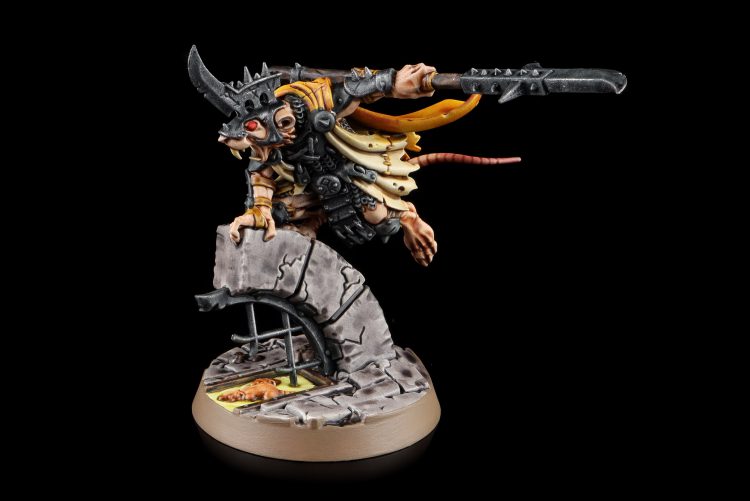
Skryre
- Overseer of Destruction – This lets you save your weapons teams from being removed if the unit they are hidden in is destroyed. As with many of these Skaven command traits this is very niche, but if you’ve invested a lot of points in hidden weapons teams then this is useful.
- Masterful Scavenger – You get two extra warpstone sparks. There’s a few ways to get extra sparks and if you’re all-in on a build like Stormfiends then you probably want to be taking advantage of one of them, but not more than that. Pick your poison between 3 heroes, a command trait or an artefact.
- Deranged Inventor – You can pick a Skryre unit wholly within 13” at the start of your shooting phase and give them +1 to hit for that phase. It’s simple and effective, +1 to hit is half of the more-more-more warp power buff so it gives you insurance for that spell failing, but the effect is easily replicated by a command ability. The more stormfiends you take, the more important this becomes as you’ll be saving that CP for unleashing hell and passing battleshock.
Moulder
- Cunning Mutator – It’s the bodyguard ability from Masterclan and Verminus again, this time keyword locked to Moulder units doing the bodyguarding. If you want to keep a Master Moulder alive, there are artefacts for that because the reason you will want to keep one alive is…
- Moulder Supreme – +1 to hit and wound for fighting beasts wholly within 13”. “Fighting beast” is Moulder keyword for Rat Ogors and Hell-Pit Abominations, eg. everything that you would love to have +1 to hit and wound on. This takes both of those units’ melee attacks up to 2+ to hit and wound, which makes these brutal hammer units hit even harder. It’s not phase locked, so works on the Rat Ogor gun as well, why not.
- Hordemaster – If a Moulder pack unit is destroyed and this model is anywhere on the battlefield, roll a 3+ and you set a unit identical to the one that was destroyed up again wholly within 13” of the general and more than 9” from enemy models. This second unit can’t itself then get recycled again. “Pack” units are the Moulder junk, but also Rat Ogors, so if you’re running a double reinforced unit of Rat Ogors and your opponent kills it, you get them all back on a 3+.
Pestilens
- Master of Rot and Ruin – A nice and simple +1 to chanting rolls. This directly competes with the High Priest generic command trait, and which you choose will depend on the specifics of the rest of your list. If you’re looking to trigger great plagues then the +1 is slightly better at that than the reroll with no other effects in play. If you have another source of +1 then the reroll becomes slightly better. Work out your total number of +1s and then bust open a dice probability calculator.
- Architect of Death – +1 damage to the ranged attack on the Plagueclaw Catapult. We’ll get to that warscroll eventually but as a sneak peak: this trait isn’t very good.
- Ridden with Poxes – Roll a dice at the end of the combat phase, on a 4+ then every enemy unit within 3” takes d3 mortal wounds. Unusual in that it’s one dice roll to trigger on everything. Looks to be of marginal utility but you really can start to build a Plague Furnace (or Corruptor) that pumps out a steady stream of chip mortal wounds, and we’ve seen the value in that from the Nurgle and Ogor books. Probably still not as good as getting those great plagues out.
Spell Lores
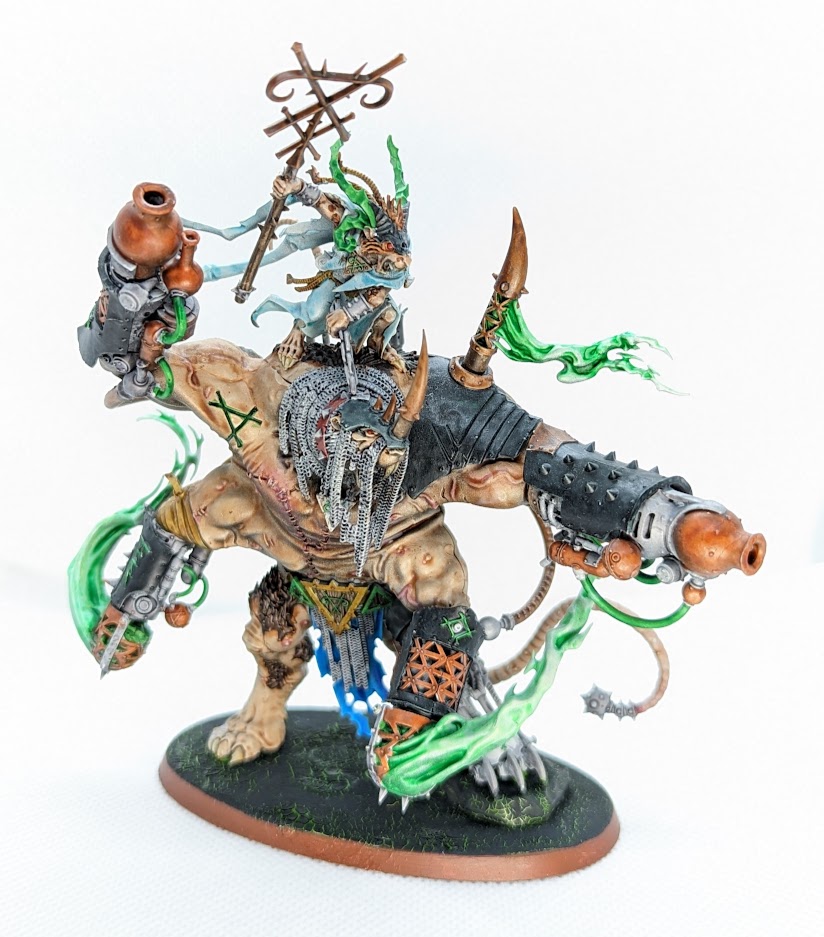
Lore of Ruin
This is for keyword Grey Seers only, which includes Thanquol but crucially does not include the Verminlords – who are all stuck with the generic spell list. I wouldn’t worry about that too much, this isn’t the best spell lore they’ve ever printed.
- Scorch – CV5, pick an enemy unit within 13” and roll a number of dice equal to the casting roll, doing a mortal for each 6. Rubbish.
- Skitterleap – CV6, pick a friendly Skaven hero within 13” and with 13 or fewer wounds (so no Thanquol, Bell or Furnace) and teleport them with the usual 9” restriction. The army does have lots of heroes that require specific positioning or want to be attempting early charges, though the Deceiver does have an improved version of this spell.
- Death Frenzy – CV7, pick a friendly non-hero Skaven unit within 13” (not wholly!) and they get to fight on death. If you’ve got the units to take advantage of this, it’s a corker. Stormvermin, Plague Censers, Rat Ogors all love fighting on death. Note that whilst there’s a hero restriction you can still slap this on something like a Hell-Pit Abomination. The Warbringer packs an improved version of this spell.
Lore of Warpvolt Galvanism
This is the Clans Skryre specific lore. Again, no Skryre Verminlords.
- More-more-more Warp Power! – 99% of the time, you’ll be taking this spell. CV7, pick a friendly Skryre unit wholly within 13” and they get +1 to hit and wound until your next hero phase, then they take d3 mortal wounds at the end of that hero phase. Cast this on a brick of Stormfiends and watch them chew through your opponent’s army. This is also decent on Ratling Guns, Doomwheels, Doom Flayers and sometimes Jezzails. Don’t cast it on a Warp Lightning Cannon.
- Chain Warp Lightning – CV7, each enemy unit within 13” takes one mortal wound. Your Engineer’s warscroll spell is better than this.
- Warp Lightning Shield – CV6, until your next hero phase the caster ignores the first 3 wounds caused in each phase. If they take a fourth wound in a phase then they suffer 3 mortal wounds and the spell is unbound. The 1%. If you’ve got an Engineer babysitting Warp Lightning Cannons and no other Skryre units then this is their spell.
Prayer Scriptures
Noxious Prayers
This is your Pestilens specific prayer list.
- Disease-disease! – AV3, pick an enemy unit within 13” and roll a dice for each model in the unit, they take a mortal wound on a 5+ unless they have the Nurgle keyword and then you are out of luck. Bit of an unfortunate rider given Nurgle’s current prevalence in the metagame but if you get this and the undulant scourge great plague off, this will shred hordes.
- Filth-filth! – AV3, pick a Pestilens unit within 13” and give them +1 to wound until your next hero phase. You may have noticed this isn’t melee locked, but Plagueclaws already wound on a 2+. Quite nice on Plague Monks to push damage through, though Censer Bearers already have access to +1 to wound. Probably your second prayer after the below.
- Rabid-rabid! – AV3, pick a Pestilens unit within 13” and give them +1 attack in melee (poor Plagueclaw). Pestilens is an aggressive melee army, this is good.
Battle Tactics
Skaven have been blessed with a bit of a grab bag here, no absolutely safe gimmes but it’s all just about doable if you build for it specifically.
- Restore the Beast – Very odd, this requires you to have a unit of Rat Ogors with 3 or more wounds allocated to it at the start of the turn to then have 0 wounds allocated to it at the end of the turn. Healing wounds is done via Master Moulders so we are in the realm of a dice roll and needing to set up for it.
- Deathmark – Pick an enemy hero with 10 or more wounds that is undamaged and then kill it with a Clan Eshin unit. Being rewarded for doing what Clan Eshin wants to do is thematic and good. For a dicey tactic, we like.
- Fire-fire! More-more! – Pick a monster and kill it with missile weapons from Clan Skryre units. Note there isn’t a requirement for it to be undamaged. If you’re playing Skaven competitively there’s a pretty good chance that you are leaning on Skryre shooting as your primary damage source so if your opponent brings a monster then, well, there you are.
- Crescendo of the Diseased Choir – Successfully chant 3 prayers from 3 different priests. Sounds tricky to do but if you’re building a Pestilens themed army it might not be as hard as you think, with all of the bonuses and potential rerolls early doors. If you’ve got the army set up for it, this can be a fine enough choice for those turns when nothing else seems really achievable.
Grand Strategies
Pretty bad! They’re all pretty bad and not particularly interesting. In fact, it’s not worth going through them one-by-one here. Every one requires you to have three Masterclan or Clans Moulder/Eshin/Verminus/Skryre/Pestilens heroes from your starting army still on the battlefield. It requires skew, it’s win-more, it’s a shame.
Units
There are a lot of unit entries in this book and shockingly, most of them are pretty good in their own way. This means we’ll be looking at most units on offer. If a unit is missing, assume that it’s terrible and not in an interesting way.
Heroes
Masterclan
Thanquol on Boneripper
The most expensive unit in the Skaven arsenal, Thanquol is the mainstay of competitive play and worth every point. Thanquol has access to the most powerful spellcasting in the battletome, being a two-spell caster with a degrading cast/dispel/unbind bonus that starts at an impressive +3. He can also choose to guzzle some warpstone for one of his casts each turn to roll 3d6 for a cast and choose two to use as the casting roll (or if the roll is a natural 13, to take d6 mortal wounds and have the spell go off without opportunity to be unbound). The issue here is that there aren’t that many spells worth using this spellcasting ability on: his warscroll spell has a 3” range for some unreliable mortal wounds, the spell lore he has access to is of limited utility as he can’t Skitterleap himself, and as a named character Thanquol can’t take flaming weapon.
In reality, Thanquol’s spellcasting job is to get out endless spells. In particular, he’s an incredible user of the Lauchon the Soulseeker endless spell, as his base is comically tiny and fits within the Lauchon bubble, letting Thanquol move 18” via Lauchon and then move again in your own hero phase.
The power here is that Thanquol is also equipped with devastating weaponry. He can take 4 Warpfire Braziers or Warpfire Projectors in any combination. Projectors are a shooting attack with an 8” range that target a unit and roll a dice for each model in range for each Projector, doing a mortal wound on a 4+. As an example, if you can get 4 enemy models in range and are equipped with 2 Projectors, you would roll 8 dice. Alternatively, Warpfire Braziers are a melee weapon with rend -2 and damage 3, getting a number of attacks equal to double the number of Braziers that Thanquol is equipped with. The most common loadout is probably 4 Projectors for truly heinous mortal wound output even into relatively small units, but there’s definitely a case to be made for two of each – you still get to do good ranged damage into most unit types and the extra punch lets you follow up into melee and makes good use out of that extra Lauchon mobility.
If this wasn’t enough, Thanquol has a 5+ ward, heals d3 wounds at the end of each combat phase and can issue the same command up to two times in the same phase once per round, the second time costing 0 CP. Position correctly to unleash hell with Thanquol and a unit of Stormfiends at the same time whilst cackling maniacally.
Lord Skreech Verminking
Skreech is a strange unit, one of the more expensive Verminlords, Skreech isn’t focussed in any one particular area and is instead overall just solid. Do note that its status as a unique Verminlord means that Skreech doesn’t get to pick from a Skaven spell lore or the generic one, so despite being a double caster will just be stuck with his warscroll spell, bolt and mystic shield.
That warscroll spell is pretty tasty though, if you can get it off. A CV8 spell with the traditional 13” range, Screech has the dreaded thirteenth spell which targets an enemy unit and rolls 13 dice, doing a mortal wound for each 4+. That’s a lot of mortal wounds but on top of that you can then summon a unit of Clanrats with one model for each wound caused by the spell. This is a little awkward as they have to be set up wholly within 13” of Skreech and more than 9” from enemy units, but is still a “free” unit.
Armed with a glaive and a plaguereaper, Screech has the best melee profile of the Verminlords… until devious adversary comes into play and then he does get outperformed by the Warbringer.
Screech also has a command ability targeting any Skaven unit that hands out +1 to hit and wound which is as you might imagine, very good. It is combat phase only, so can’t be used to replace more-more-more warp power for your Skryre units.
Finally, Screech gets to pick itself a buff in each of your hero phases that lasts until the next one, but you can’t pick the same one more than once. It’s a pretty big list, but you’ll likely be leaning on the +1 cast/dispel/unbind, rend -3 glaive and d3 wound heal buffs.
Verminlord Warpseer
Whilst we’re in the midst of lots of big, wordy, monsters it’s probably worth covering the base Verminlord statline. Verminlords have 13 wounds, a 4+ save, a 5+ ward, move 12”, cast two spells and have some piddling tail attacks as a ranged weapon. They’re all leader behemoths and only have access to the generic spell lore. For the most part, they’ve got 6 melee attacks with damage 2 and rend -2.
As a masterclan Verminlord, the Warpseer is more of a general utility piece rather than interacting with a specific clan. You get a 13” wholly within aura of bravery 10 which is a huge increase on an army where bravery floats around 4-6. The Warpseer also counts as two masterclan heroes for your battle traits so the very simple (but expensive!) combination of Thanquol and a Warpseer will fully unlock the three clawsteps ahead masterclan ability.
For spells you get dreaded warpgale, a CV8 spell with an 18” range that does d6 mortal wounds and halves the target unit’s run and charge rolls and switches off fly. That’s amazing, but CV8 with maybe a +1 from arcane terrain is not happening as often as you’d like. Finally, the Warpseer gets +1 to its save from its scry orb, which you can sacrifice to throw at an enemy unit within 13” and do d6 mortal wounds.
Overall a tough sell in a crowded field. Verminlords are just generically pretty good and the Warpseer is on the cheaper end of them, but beyond the bravery aura these abilities are mild and it has the most generic possible attack profile.
Warpgnaw Verminlord
Forge World nonsense, the Warpgnaw is a Verminlord that hasn’t been properly updated for the new tome. It’s got the previous edition’s 12 wounds and the previous edition’s approach to Verminlord points.
There’s not as much going on with the warscroll here as other Verminlords, you get 4 attacks with degrading damage that starts at 5 so it’s pretty choppy. It can be deployed in reserve and instead get set up at the end of your movement phase within 6” of a gnawhole, has a tedious -1 bravery aura of just 3” and a warscroll spell with CV5 that picks an enemy unit within 13” and kills a model of your choice if you can roll equal to or over their wounds characteristic. Fine.
I havered on including this because it’s very obviously an outdated unit from another time, but for as long as it’s matched play legal in its current state you are getting a very cheap, very weird Verminlord. There’s no combos with the rest of the army going on here, you’re buying a melee monster at a discount rate. Compared to the damage output you can get at this kind of cost in the rest of the book, and precarity of Forge World AoS in general, I wouldn’t rush out to buy one.
Grey Seer
The foot Grey Seer is brilliant. They’re bargain basement cost for a two-cast wizard and on top of that the unit gets to copy Thanquol’s warpstone chewing ability for a 3d6-drop-one cast. The warscroll spell is fine, CV7 for a 13” range spell that does d3 mortal wounds and inflicts -1 to hit in melee if you can beat the target unit’s wounds characteristic on 2d6.
Grey Seer on Screaming Bell
The Grey Seer on Screaming Bell is less brilliant. Once the centrepiece of the Skaven battleline, the bell now struggles to justify its inflated points cost. You get a two-spell caster and a lot of rules, but none of it quite adds up to a coherent unit.
As a spellcaster the bell has a degrading bonus to cast (and chant prayers) starting at +2, which is nice, but suffers from Thanquol syndrome of not always having access to the spells that you want to be forcing through with that big bonus. The warscroll spell is an OK if short ranged nuke that is utterly matchup reliant, being a mini Ravenak’s Gnashing Jaws effect that doesn’t hit flyers. In addition to this in your hero phase you can decide to give up your casts and instead become a priest. This trades both casts for one prayer and crucially the bell does not have the priest keyword by default, so you do not get to pick a prayer enhancement. If you could take Curse, this would maybe be interesting but as it stands you are essentially trading your spellcasting for access to Bless, which, well it’s an option that is there if you are desperate for a 6+ ward.
You can also ring the bell in your hero phase and get a random effect on a d6 roll. This ranges from hurting itself, debuffing enemies and hurting enemies. These are all OK effects though you will miss the old bell’s result of +1 to cast for friendly units in an aura. The other problem here is the old bell was a 2d6 roll, making those extreme results of hurting yourself much less likely. Now on a single d6, every outcome is as likely as the other as it’s just unreliable.
The final positive ability here is the bell’s real new gimmick, which is the ability to more reliably summon a Verminlord (previously a double 6 ability on ringing the bell). You do this by rolling a dice (on a 1, the bell blows up). Otherwise you add the number of wounds taken by the bell and on a 13+ you can summon a Verminlord. ‘Free’ summoning of powerful models is obviously good and I won’t pretend otherwise, but there’s not much about the bell that compels your opponent to start putting the chip damage into this that you want to be able to summon with. If you want a Verminlord, take a Verminlord.
Clans Moulder
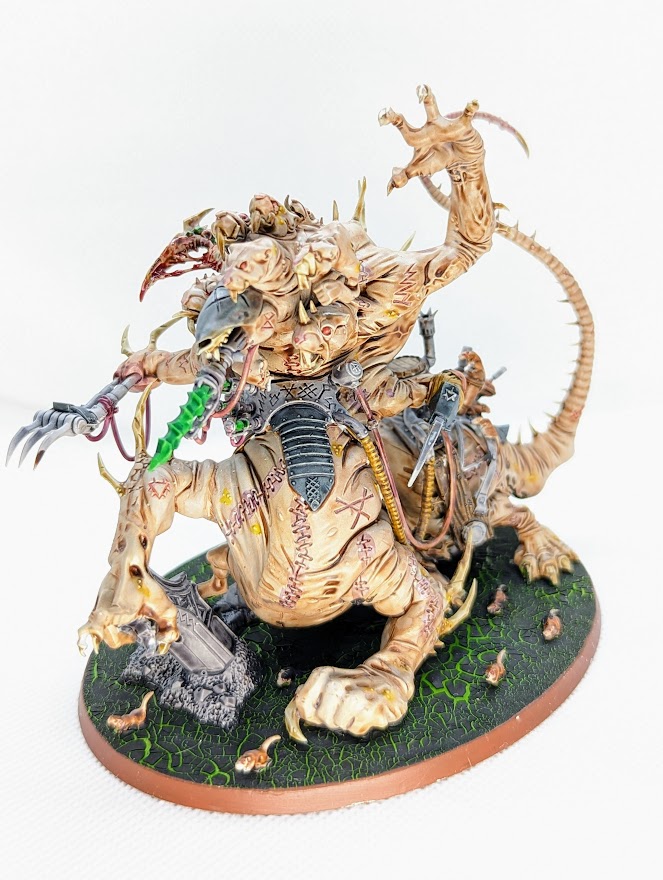
Master Moulder
A bargain basement, deeply fragile warscroll. The Master Moulder has some attacks that certainly exist on its warscroll along with 5 wounds and a 5+ save. It’s there for its buff abilities of which you get three.
It can crack the whip on a Moulder pack unit wholly within 13” in your movement phase and give them +3 to run and charge, and +1 to wound. This doesn’t stack but both of these abilities are extremely good and that there’s no dice roll or resource expenditure here. In your hero phase you can pick a Moulder pack unit within 3” and heal d3 wounds on them. Finally, there’s a command ability that lets you bring back a Moulder pack unit on a 3+ when it’s destroyed as with the Hordemaster command trait.
Obviously you’re taking these if you’re going Moulder heavy but actually, only if that Moulder-heavy list is pushing Rat Ogors. The ‘pack’ keywording on all 3 of these abilities means that outside of the weird battle trait, this model has zero interaction with the Hell-Pit Abomination, which is a bit of a shame and does contribute to what holds that behemoth back.
Clans Eshin
Verminlord Deceiver
The most expensive (by a whisker) Verminlord and probably the one you’ll see most often. The Deceiver has a very welcome rend -3 on its melee weapon and a d6 shot Doomstar missile weapon that can do mortal wounds on 6s to hit. The Deceiver is your alpha-strike Verminlord of choice and has three abilities geared around making that happen.
First, it can’t be picked as a target for shooting attacks from more than 9” away, which will help keep it alive in those early battle rounds, especially as it is one of the few Eshin units that cannot start off the board. Secondly, it’s got a command ability for +1 to hit and wound on any Eshin unit in the combat phase. Used on itself, it pushes those rend -3 attacks to hit on a 2+ and whilst the Deceiver naturally wounds on a 2+, that does degrade and this lets you keep your efficiency up as the battle progresses.
Finally the Deceiver’s warscroll spell is a turbocharged version of skitterleap from the main lore. With a CV6 (and 18” range if you wanted to use it on something else) and the same target requirements as regular skitterleap, this version instead lets you set up more than 6” from any enemy models, making those teleport charges far more likely to connect with your target.
Deathmaster
The 5-wound Eshin hero with the cool new model. Deathmasters are kind of an odd-duck but as ever with Skaven, can shine if the dice go your way. With 10 attacks across their ranged and melee profiles, all with d3 damage, they do d3 mortal wounds for every 6 to hit. This gives them good spike potential if the stars align, and their output is reasonable otherwise.
The problem is delivery – with no native ability to deploy from off the board you are reliant on Skitterleaping into position or using the Deathmaster’s gimmick ability: hiding in a unit of Clanrats, Stormvermin or Night Runners. None of these units can deploy off the board either, so you’re still stuck running them up the board. Unless you stick them in a Warp Grinder. At this point, you might be best off Skitterleaping.
These are a little expensive to casually throw away and they will fold immediately if targeted by the enemy, but if you have an alpha strike plan in mind (and most Skaven lists do!) these can find a place.
Slynk Skittershank
The rare Underworlds warband that actually has a role in regular AoS. Slynk comes with his clawpack and whilst rocking that typical Underworlds expense they’re totally viable, especially in an Eshin list if you’re looking for that third hero and don’t want to double up.
Slynk himself has a very similar profile to the Deathmaster, trading one less ranged attack for one more melee attack – which makes him a bit better outside of rolling 6s. The unique part of Slynk’s warscroll is that instead of hiding inside a unit, he can join his clawpack in deploying off the board and appearing at the end of your first movement phase more than 6” from enemy units. On top of this, if both Slynk and his clawpack make it into combat and Slynk is within an inch of them, he gets strike-first and can then make a retreat move after fighting for the first time. This probably sacrifices your clawpack, but can help keep your fragile hero alive to strike again. This is a “can” ability, so if you don’t want to retreat then Slynk can happily sit there and if your opponent can’t shoot off the clawpack will retain his strike-first ability.
A word on the clawpack itself, beyond being a delivery system and buff piece for Slynk, it actually has reasonable output. They’ve apparently stolen the Eshin hero poison and do d3 mortal wounds on a 6 to hit (with 13 total attacks in the unit), so combined with Slynk you have the potential to spike quite high with mortal wounds compared to a similar small unit of Gutter Runners.
Clans Verminus
Verminlord Warbringer
Your melee specialist verminlord. As mentioned, it loves the extra attacks out of devious adversary across its two melee profiles. The spike-fist comes with just two attacks by default with rend -2 and a nice damage 3, but the incredibly named ‘Fist of Verminus Supremacy’ rule changes that to 6 damage on a 6 to hit. So, more attacks on that are very welcome.
Like the Deceiver, the Warbringer gets a +1 to hit and wound command ability, this time for Clans Verminus. On top of this, the Warbringer can also get the lesser spotted reroll buff for its wound rolls by being within 13” of 3 Skaven units. It gets a boosted version of the death frenzy spell, letting you target d3 friendly units. Death frenzy is one of the better spells for a melee Skaven build, and chances are that if you’re taking this unit it will be walking up the board surrounded by friends who also want to be in melee – so it’s a good combination.
You won’t see this as much as the Deceiver simply because dreaded skitterleap is so good, but if you’re running the right kind of army for it this will be the hardest hitting verminlord, and isn’t just a solo operator.
Clawlord
If you’re running a big block of Stormvermin this model has a command ability for +1 attack for them. That’s about it, really. There’s an ability to get more attacks as it takes damage to get some comedy melee profile but really it’s all a bit fragile and the heroic action gimmick for Verminus doesn’t quite get there. Because it’s combat phase only, you also can’t stack this command ability with the Warbringer one. There’s a use-case, but it’s very niche.
Clans Skryre
Arch-Warlock
An unusual foot-rat, being quite tanky with 6 wounds and a 3+ save. The warlock family of models are largely buff caddies for the big Skryre guns and this offers you a version that’s harder to snipe (and two-cast) for roughly 40-point premium over the smaller ones. Stormfiend builds will quite often see double cheap warlocks as protection for getting your buffs sniped out, so this can do a similar job on a budget compared to that combination.
If you want your opponent’s undying respect there is a combo to turn this into a very funny melee missile. Stick devious adversary on it, pick up flaming weapon and lauchon the soulseeker then warpstone spark up and go flying into combat. With d6+2 attacks at 3s and 2s with rend -2 damage 3 and 3 attacks with the same profile it can chop some stuff up (and then probably die horribly). Fun!
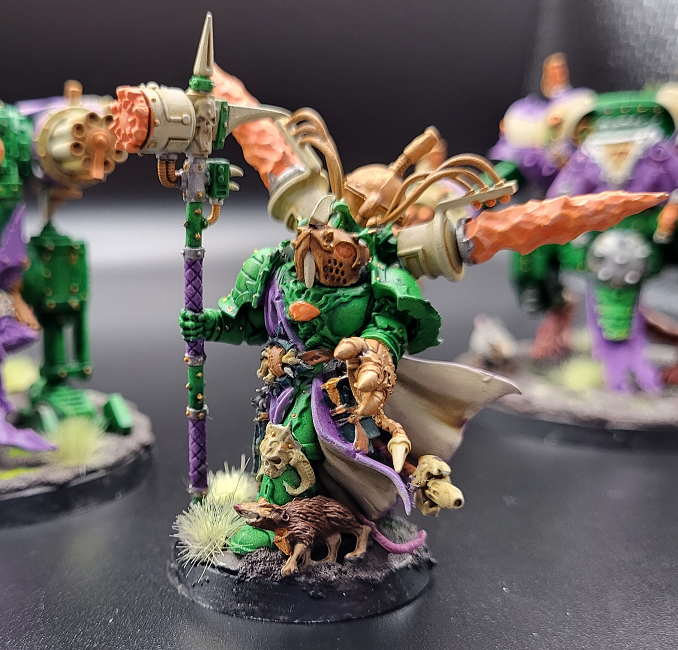
Warlock Bombardier
The first of your two cheap warlock choices, the bombardier is slightly more expensive and packs a doomrocket: a 18” range gun with d3 shots and damage 3. Given that sparks can up the damage output of multiple models in the shooting phase, this can actually do some decent work. If you want the bombardier to instantly blow itself up, you can crank those shots up to d6 and then take d3 mortal wounds for every 1 to hit.
It’s worth mentioning that both this and the engineer below have the same spell, CV5 and a 13” range for d3 mortal wounds is nice, but you’ll find they’re often cowering out of reach or trying to cast more-more-more. You can overcharge the spell as well if you like, for d6 mortal wounds. This will put d6 mortals back on your engineer if the spell fails or is unbound, but is a very nice nuke and with gnawholes and sparks they actually cast quite reliably.
Warlock Engineer
The cheapest possible warlock, it’s a good cheap wizard. Despite lacking the doomrocket it does still pack a cheeky pistol: it’s got a low range but 3 shots with rend -2 will occasionally remove an enemy model. The key to the engineer, beyond being cheap, is that because of keywords it is the only hero that can activate the overcharge ability on the Warp Lightning Cannon. If you’re taking those, you’re taking this.
Clans Pestilens
Verminlord Corruptor
A weird verminlord, and the cheapest. Instead of a fixed 6 attacks like the melee weapons of other verminlords, plaguereapers have a degrading and random attacks value that starts on 2d6, moves into 3d3 and then starts getting very very bad. They also get to do a mortal wound on a six to hit (and the attack continues) so if you take the blade artefact and just roll a whole load of 6s, this can do huge amounts of damage. That’s a big old ‘if’. Beyond that, it does some chip mortal wounds at the end of the combat phase, gets the +1 to hit and wound command trait for Pestilens packs a CV7 spell for a 4+ horde clearer with a 13” range.
By far the most random verminlord, and the degrading attacks is brutal. Pestilens is highly synergistic and relies heavily on prayers rather than spells, so this scroll comes across as a bit of a miss. If you do run the artefact on this and have the god-round of doing huge damage, write in.
Plague Priest
It’s a cheap foot priest. You’re taking this either for Curse shenanigans with a gunline, as a nice cheap buff for Censer-bearers or as part of some Rube Goldberg great plague engine.
Plague Priest on Plague Furnace
The much more expensive but wildly more durable priest. 15 wounds, a 4+ save and 5+ ward will keep it in the game for a long time, as will its -1 to be wounded in melee. It’s got an unusual attack profile in the great censer, which picks an enemy unit within 3” and does a degrading amount of mortal wounds, starting at a meaty d3+4.
The furnace suffers from a similar mobility problem to the bell, which is that it cannot move at all unless it starts the move within 6” of 10 Skaven models. This means it needs to be babysat, and you can find yourself in situations where it becomes immobile because its escort has been killed or just charged off to fight something and the furnace fails its own charge.
Another huge positive for the furnace and honestly one of the main reasons to take it is that it has a 13” wholly within aura of not taking battleshock tests for friendly models. This is huge, and a key weakness for Skaven and Pestilens in particular. In a mixed build, this is too expensive and would be replacing the position of Thanquol or a verminlord without much justification. In a Pestilens build, it can work.
Battleline
The Skaven book’s battleline structure is different to every other army in the game. With two generic battleline options, you can unlock different battleline choices for having a hero with the appropriate keyword. This hero doesn’t have to be your general, but the trade off is that they only unlock each unit as battleline once. E.g If you have a single Master Moulder you can take one unit of battleline Rat Ogors and one unit of not-battleline Rat Ogors. If you have two Master Moulders, both could be battleline. Finally, note that this unlocking is tied to the unit, not the hero, so your single Master Moulder could bring battleline Rat Ogors and Giant Rats.
Because of this, we’ll cover both generic choices here and then each subheading will include any units that can be made battleline with an appropriate hero.
Clanrats
Just fantastic, they are exactly what this army needs them to be. 25mm bases means you can laugh in the face of coherency and string them out to your heart’s content if needs be. A 6” move, +2 to run rolls and the ability to retreat and charge give them unusually high mobility in the ‘trash battleline’ role and for free at the end of each battleshock phase you can bring d3 of them back.
OK, they do essentially no meaningful damage and are a single wound sat behind a 5+ save so die in droves, and will then self-destruct with their bravery 4 but the latter is something the army does have ways of working around. Otherwise, 100 points for 20 bodies with those little extra rules is a brilliant deal. Whilst the Skaven book does have lots of exciting ways of filling battleline, do not forget about the humble Clanrat.
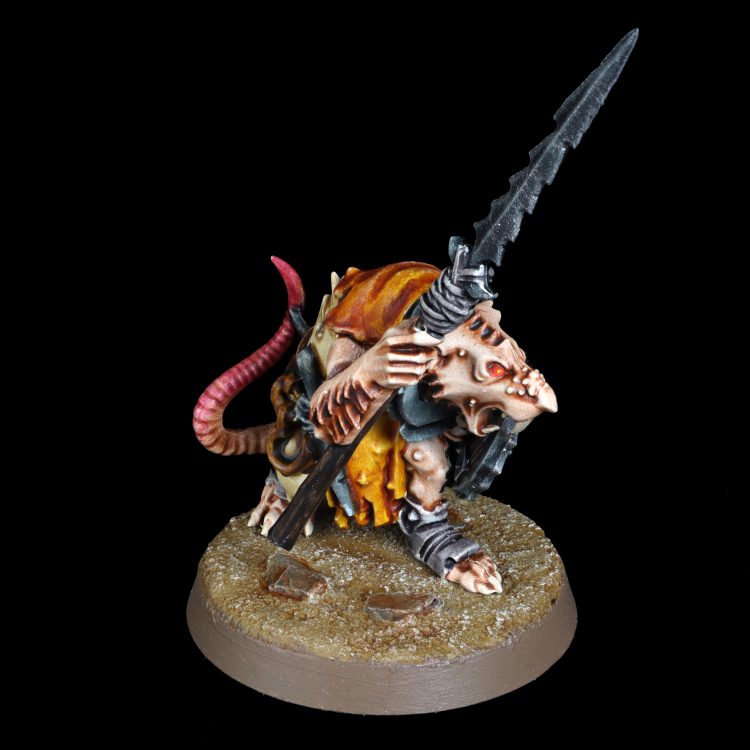
-Credit: Pendulin
Stormvermin
A mix of the ‘typical’ AoS heavy infantry profile with Clanrat speed and retreat and charge. They end up as a sort of dual role unit, but each role somewhat dissuades you from dipping too hard into the other. A double reinforced unit of 30 will have huge reach to fight in every rank and takes buffs quite nicely to be a decently punchy melee unit. They don’t run cheap, but you can get them hitting and wounding on 2s quite easily and they will shred most non-save stacked enemies.
They also have a bodyguard rule, so you can transfer wounds allocated to Skaven heroes within 3” to the Stormvermin instead on a 4+, or 2+ if they’re Verminus. Now, Skaven do have a few ways to gain access to bodyguards so how important this is will depend on what you’re wanting to bodyguard and why, you’re still paying for that offensive profile so they’re quite expensive in this role. That being said, if you want to walk a Verminlord Warbringer up the board then these will bodyguard it exceptionally well and be one of the units the Warbringer wants around itself anyway.
In truth unless you have one of these two specific plans in mind for them, this is probably one to leave on the shelf.
Clans Moulder
Giant Rats
Do you like cheap filler? Do we have some cheap filler for you. Because they can be battleline these are actually not as cheap as they should be, you get 6 big rats for 60 points. This is a terrible deal compared to Clanrats who get 14 more bodies for 40 more points. Beyond being the cheapest possible battleline if you are bringing a Master Moulder along, these can be a tempting take in the “oh I’ll grab an endless spell” points bracket. With a move of 8” these will happily screen, run onto objectives and generally die horribly in a useful way. If you get a unit of 6+ of them into combat they’ll have rend -2 as well, which is just funny.
Rat Ogors
In the running for most improved warscroll from second edition, Rat Ogors are surprisingly tough and hit hard. You get two per reinforcement, and they come with 6 wounds and a 4+ save so the defensive efficiency isn’t amazing, but is just about within acceptable parameters. On the offense, you get 4 attacks with damage 2 per model and exploding 6s to hit. Also, for some reason, one-per-two can have a pretty mediocre gun.
Reinforced, or double reinforced, units of these aren’t too expensive and can lay down some of the biggest melee hits in-faction, especially with the buffs and unit recycling available to Moulder. That you don’t see these more is a testament to how bad the models are and how much the Island of Blood ones go for on eBay.
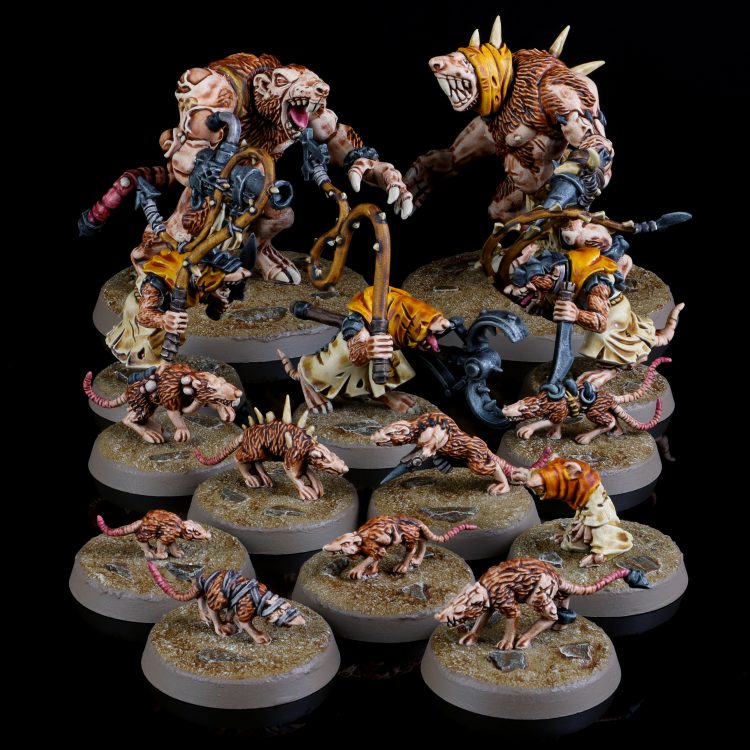
Credit: Pendulin
Clans Eshin
Night Runners
They’re OK, but get overlooked by the sheer weight of the Skaven catalogue (and those awful minis don’t help either). You’re getting half as many per unit as Clanrats but for 10 points less. They’re a bit faster, a bit squishier and might do a smattering of mortal wounds. Really you’re taking these for two reasons: you’re pure Eshin and need something to hide a Deathmaster in, or you’re specifically buying their pre-game move. Pre-game moves are absolutely fantastic, but this is a 2d6” move so far less reliable than other armies can achieve out of the same mechanic.
Gutter Runners
One of a few standout Skaven units good enough to actually build around, but also just fine taken as a smattering of small units, or even not at all. You get five rats with 3 throwing star attacks and two decent melee attacks, all of which can proc mortal wounds on 6s to hit. You can deploy them off the board and then bring them on a board edge in your first movement phase.
Two uses here: loading up on a few medium-to-big sized units of these will have good alpha strike potential, especially with Eshin buffs up, or a couple of minimum sized units are great for disruption, objective play and battle tactics. With how easy gnawholes are to shut down in this book, it’s worth a consideration at least with how poor Skaven can be at scoring early.
Clans Skryre
Skryre Acolytes
Infamously one of the most real money expensive non-hero units in the whole game due to being a unit taken in fives and sold as single, expensive, models. Outside of this rep, they’re hobgrots on steroids. You get five of them for kind of cheap, and they get a single 9” range shot with rend -2 and d3 damage.
In a previous life these had a job as the sole cheap Skryre battleline and screen, a role now done much better by many other units in the book with the opening up of build options. Now if you’re taking these it’s because you spend $600 on them, or for their damage. The damage is admittedly very good and they take the Skryre buffs very well. The obvious downsides to them are pretty hefty though and punt them well into the realms of please do not spend your life savings on these. Big units start adding up in points quickly and with a range of 9” the defensive profile of one wound, a 6+ save and bravery 4 is a colossal risk of dying before doing anything if your opponent has a single unit with a gun.
Stormfiends
If you’ve played with or against a Skaven army any time in the history of Age of Sigmar, there’s a good chance these were involved. Infamously one of the most points expensive non-hero units in the whole game, due to costing 320 points and wanting to be reinforced.
An unusual and complicated unit, each model per three has to be equipped with one of two weapons specific to that one model per three. This requirement on loadout means you will always have one gun, one melee and then one choice of either loadout. Diving too deep into Stormfiend loadout would take all day so 90% competitively you will be looking at a unit of 6-9 of these equipped with: windlaunchers, ratling guns and then whichever melee weapon (shock gauntlets are generally preferred). This puts Stormfiends in the role they excel at, a brutal shooting unit. Whilst the guns are pretty good on their own they really shine when handed out the Skryre shooting buff package of more-more-more warp power and a warpstone spark. These armies put out obscene quantities of damage and naturally lean into a castle playstyle.
Beyond this, Stormfeinds have enough melee power to take care of themselves if charged by anything but the biggest melee threats (and that’s after they get a horrific unleash hell) and a big chunk of wounds that makes them unusually difficult to remove for a Skaven unit. If you’re running a unit of 6, you will have to take 20 damage to remove the first gun from the unit.
There’s a case to be made for a unit of 3 of these as a troubleshooter in an army going in another direction for pure damage, and in that case the warpfire thrower probably wins out over the windlauncher, but this is unusual.
Clans Pestilens
Plague Monks
Once an unholy terror of a melee trading unit, Plague Monks have struggled to find a place recently. This is another horde unit like Clanrats and Stormvermin, but this time pretty strictly in the melee buzzsaw role. They throw out 3 attacks per model on the charge and get rend -2 on sixes to wound. This is all fine enough, they’re probably a little spendy for their fragility, but take the very many buffs available to them in Pestilens quite well.
It’s probably a combination of fear of bounty hunters into their fragile bodies, bravery 5 into a Nighthaunt meta and the glow up the unit below got, but these tend to not show up very often. A little package of 30 Plague Monks and a Priest is only 370 points so if you can shore up the Bravery issue there’s worse ways to have a big unit that wants to get stuck in.
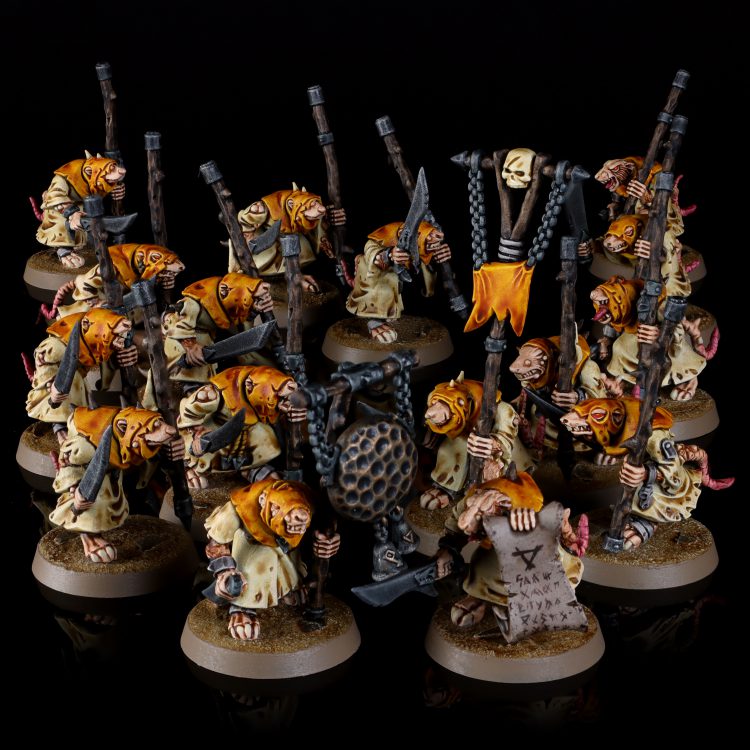
Credit: Pendulin
Plague Censer Bearers
The other unit in the running for most improved warscroll in the new book, and they really do hit hard. Censer Bearers get 4 attacks each on the charge with a pip of rend and a spicy damage 2. Like Plague Monks, these will happily guzzle up any buffs you can feed them from their subfaction but honestly barely need it. 5-10 of them are a cheap, scary trading piece and bigger units will batter things into submission.
As is traditional with Skaven they’re terrifyingly squishy if your opponent can hit them first, but they do have a surprising two wounds, and are -1 to be wounded in melee. Along with the Pestilens suite of buffs, these are a fantastic target for death frenzy.
Other
Clans Moulder
Packmasters
Bizarre unit that exists because the models do. Basically a budget Master Moulder that doesn’t take up a hero slot but can’t take any of the excellent Moulder enhancements. You get the crack the whip ability for +3 to run and charge rolls for pack units which in a vacuum is an excellent thing. If you can afford the extra points for the Master Moulder though, do that.
Clans Skryre
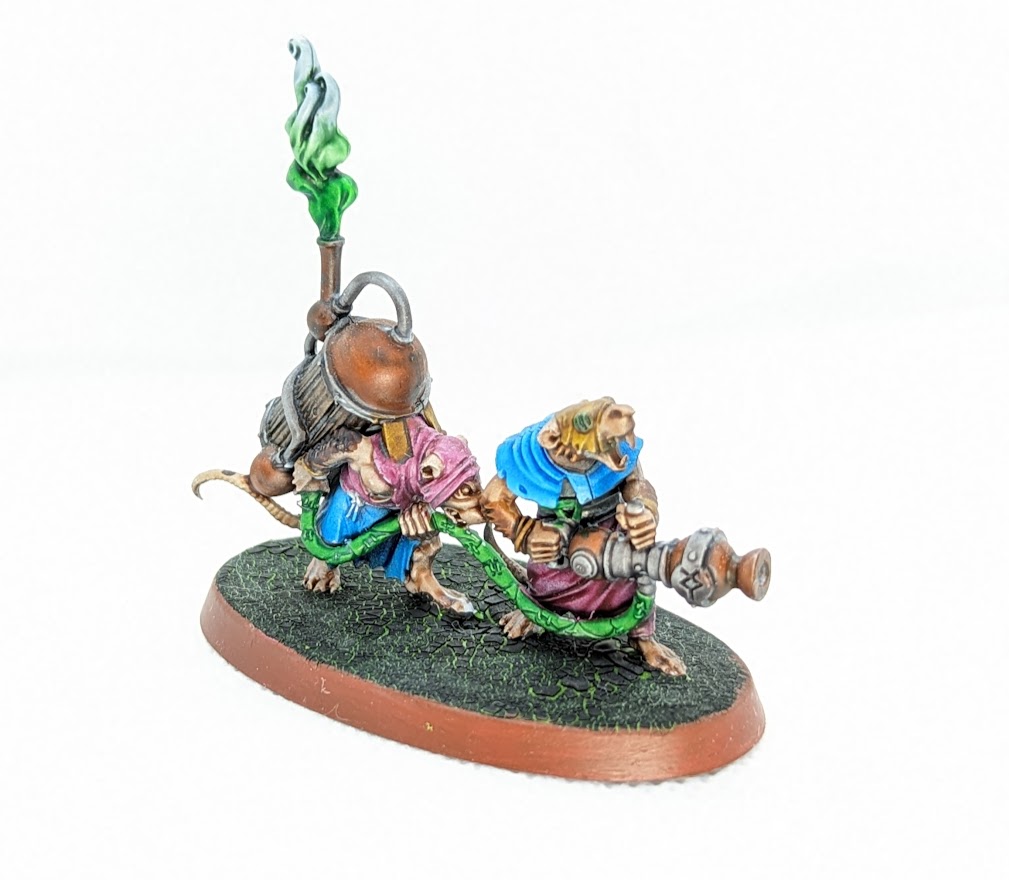
-Credit: Matthew Ward
Doom-Flayer
We start the selection of hidden weapons teams with the awkward melee one. All of the weapons teams bar the grinder can deploy inside a unit of Clanrats or Stormvermin (you write down which in secret at deployment). You can put one weapons team in for every 10 models in the unit and if the unit dies with the weapons team in there then the weapons team dies too. Each weapons team has a different timing for when it can pop out.
The Doom-flayer is, on paper, fine. For the price of a mid-range endless spell you get d6 (or 2d6 if you don’t mind a risk of blowing up) attacks with rend -2 and damage 2. If you’re daring enough to go for the 2d6 attacks this is more often than not better than the d3 mortal wounds most endless spells will give you. The problem for the flayer is one of timing, it deploys from hiding in your charge phase which means in practice you can only use it offensively and the unit it’s hiding in also has to be moved into place for it to be used offensively.
Ratling Gun
Now this is a good weapons team. 2d6+3 shots, going up to 4d6+3 with a comically high chance of killing itself, these will do good damage for their points when they emerge in your shooting phase and are incredible recipients for general Skryre buffs. Three of them with a spark up won’t set you back too many points and will put an incredible amount of damage 2 warp-lead down the field. They’ll almost certainly then immediately get destroyed, but if the trade is good enough you’ll be happy. Watch for the very limiting 12” range.
Warp-Grinder
For low cost and an extra drop you can give any non-monster or warmachine in your army the ability to deploy off the board and then set up at the end of one of your movement phases with the usual 9” restriction, and wholly within 13” of the grinder. On top of that, it fights like an un-overcharged flayer. If you need it, it’s there and it’s good at what it does.
Warpfire Thrower
Picks a unit within 8” and rolls a dice for each mode in the unit within range, doing a mortal wound for every 4+. You can make that a 12” range and a 3+ to do mortals at the expense of the thrower very likely violently exploding immediately after. This competes directly with ratling guns and is very mildly more expensive but also requires zero extra support to do what it does. Ratlings are probably the better all-comers choice but if your meta is full of high armour save infantry, this will do work.
Artillery
Plagueclaw Catapult
Skaven have an unusually large number of artillery pieces and this is the most conventional, and worst. One shot, rend -2, d6 damage. No thanks! Pass. It gets 2d6 damage into units with 10 or more models? Cool, I’ll pass. This is the kind of artillery piece that Mortek Crawlers made irrelevant an entire edition ago and nobody even takes Mortek Crawlers anymore.
Warplock Jezzails
At first you’ll be like “why are these Artillery” and then later you’ll be stroking your chin like “why aren’t Longstrikes Artillery”. Friends, these are just Skaven Longstrikes. You get half the shots, but they’re half the points. This actually works out pretty well! Because they’re Artillery and Single you’re limited in how many total you can get, but they’re cheap enough that unlike Longstrikes you don’t need to invest anything extra into them for them to do a decent job. You can take as many as you can and make pew pew noises or you can take one or two units and they’ll be OK.
Warp Lightning Cannon
Weirdest gun in the game? Roll a dice to determine the “power” of the shot and then roll six more dice and do a mortal wound for each roll greater or equal to the power roll. This is the ur-Skaven warscroll right here, with incredible potential to spike or fail utterly. If you’re got a friendly Warlock Engineer (the specific scroll, remember) knocking about you can choose to roll twelve dice instead of six and take d3 mortal wounds for every 1 on those dice, which you’ll do. This means if you roll that magic ‘1’ on the power dice, you’ll be doing 12 mortal wounds to the target (and OK, maybe blowing yourself up too).
On top of this the gun itself has a 24” range and a 3” move so you do get to project that power quite far, but it’s not that far and your opponent can deploy around it. Skaven have lots of good ways to deliver damage from afar, and this is definitely one of them that’s worth your time. They’re pretty cheap and cheerful so you can afford to take a few and at that point you start to mitigate the random factor of the weapon somewhat. Note that it’s a shooting attack, not an ability, even though it definitely reads like an ability so yet another very scary unleash hell option (particularly if you have Thanquol around to unleash with the battery).
Behemoth
Doomwheel
The poor Doomwheel doesn’t quite get there. A little too fragile, too random, too pricey and occupying a behemoth slot really pushes it out of contention. This is a shame as it’s so close to being useful, with a good pokey gun and the rolling doom rule letting it move over units with a wounds characteristic of 3 or less and doing mortal wounds when it does so. They’re a lot of fun if you do take them, though it would be nice to see a re-write on more-more speed as the punishment for rolling a double 1 (your opponent getting to move the model) is far too big currently.
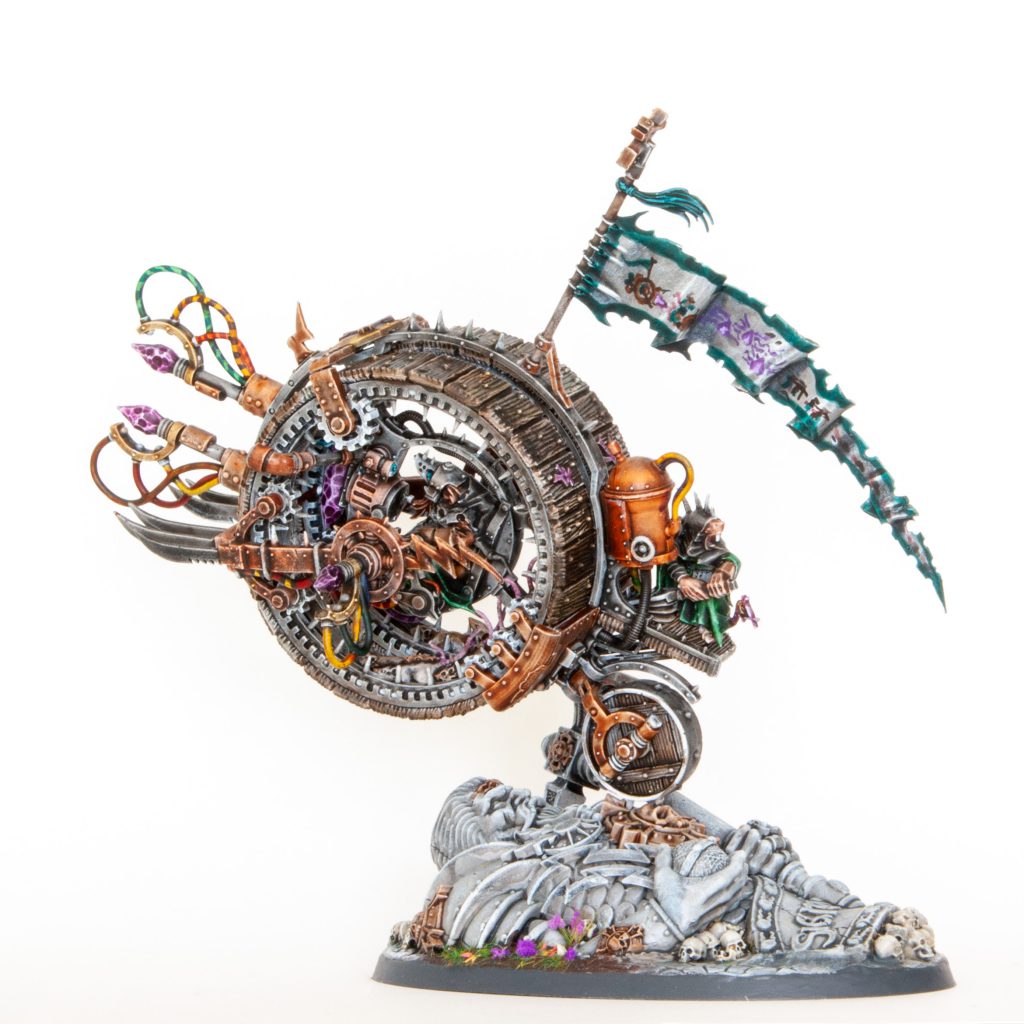
-Credit: Michael Blatherwick. Instagram: rogue_michael
Hell-Pit Abomination
Another unit that’s so close to being great but doesn’t quite make it, though has a better argument than the Doomwheel. The high points here are really high, with a bonkers offensive output if the Hell-pit can get into combat it’s terrifying: 6 attacks with rend -3 and damage 2, another 6 attacks with rend -1 and damage 3 and then a brutal horde clearing ability that very reliably puts mortal wounds onto every model within 3”.
The problems are getting into combat in the first place. It’s squishy with 14 wounds, a 5+ save and no ward (it can come back to life if you’re good at rolling a 5+) and it’s unreliable and slow, with a 2d6” move. You can mitigate some of the weaknesses via the Moulder allegiance abilities to make it tougher or more reliable in speed (though, crucially, not any faster) but you’re still left with an imperfect monster competing against more reliable behemoths in the rest of the army. It’s close though!
Quick note that this is a Mortek Guard blending machine so if that type of heavy infantry or horde infantry makes a resurgence in the game, keep this in mind.
Endless Spells
Warp Lightning Vortex
Once the terror of Age of Sigmar, now heavily toned down but still good. You get to set up a triangle of vortexes, with a pretty tight 13” range on the first one to go down. A new addition this edition is also the requirement for each vortex to be more than an inch away from every other kind of model and spell, which can really hamper your ability to get it into a position to hammer your enemy to best effect.
What these vortexes do is twofold: first enemies within 3” of any of them can’t run, which is quite nice when you’re trying to keep your opponent out of your castle. Secondly you get to roll a dice when the spell is set up and at the end of each movement phase for each unit within 6” of a vortex and do d3 mortal wounds on a 4+. You get +1 to this roll for each vortex the unit is within 6” of, so that units having to move through it are in the most trouble. This is where your issues with setting it up and that inch away come in, it used to be possible to cast this over a unit to get it trapped inside immediately and that isn’t really possible now. Still, getting to double tap this damage on the turn the spell goes up is very nice if you can get it in the right location.
Bell of Doom
An aura of no battleshock tests taken for Skaven wholly within 13”. It moves a random 2d6” which is a bit of a shame, and after it moves if you roll 13 on 3d6 it blows up and does mortal wounds which is also not ideal but also not particularly likely.
You don’t see this massively often but it does perform a useful function, especially now that the Screaming Bell isn’t providing the same benefit. Most players will choose offensive endless spells but if Nighthaunt remains a meta terror and the rules that deny inspiring presence continue to increase then this is a tool in the toolbox, and cheap.
Vermintide
A cheap offensive endless spell and probably the least obviously useful of the three. It’s got a good long cast range of 18” and a predatory move of 7”. Damage wise it’s got a 3” range and picks a unit to roll 13 dice at and does a mortal wound for every 6, which is not going to set the world on fire. The good sides to this are that it’s affordable and competes quite well in its price bracket, plus it is on a big 120×90 base which combined with the long effective range it has makes it a good piece for blocking up and controlling board space.
Faction Terrain
Gnawhole
You get to set up three Gnawholes. Gnawholes are pretty big and have pretty tight deployment restrictions: more than 3” from objectives and terrain features, more than 18” from another Gnawhole and wholly within 8” of a board edge (given the size of Gnawholes, this basically means touching a board edge).
Gnawholes are impassable, which is nice for play experience if nothing else. You get +1 to cast, dispel, unbind and chant within 3” which is nice, especially if you’re looking to get that reroll chants buff up early. Most importantly, you can teleport between them – your unit has to be wholly within 6” at the end of your movement phase and your opponent can block it with the usual 9” restrictions but also just by having a unit anywhere within 3” of the destination gnawhole (though note that the original Gnawhole does not have this 3” restriction).
It’s easy to look at the high casting values of Skaven spells and go “ah but you get to place 3 pieces of arcane terrain for free” but the reality is that the deployment restrictions on Gnawholes and the near universal 13” range on Skaven offensive spells makes them incredibly awkward to use for this purpose, outside of the Skryre castle.
Example Lists
Zach Boyce – 18th place at Everwinter GT (December 2022)
Not the highest placing Skaven list at the event, but a good example of the ‘classic’ competitive approach to Skaven – Thanquol, Stormfiends, Clanrats, buff pieces and flavour to taste.
Clanrats are the all-purpose screen, the Arch-Warlock is there to buff the Stormfiends who put out a good deal of ranged firepower, the Warbringer is a powerful counter-charge piece when your opponent gets to your screen and Thanquol is just an incredible all around troubleshooter who can get around the board very quickly with Lauchon to threaten almost anywhere.
Brandon Eaton – 1st place at Devon Destruction II (November 2022)
Brandon's List - Click to Expand
Just to prove that they’re very very good, or we’re very very wrong, Brandon’s only gone and won with a Screaming Bell.
The Bell is very proficient at casting Death Frenzy and the army doesn’t leave points for Thanquol otherwise, so it does make sense, and a potential ‘free’ Verminlord isn’t nothing. Otherwise it’s got three priests to get the great plagues going nice and early, Clanrats that can screen and also get out over the board to be a bit more active than in the gunline castle and finally the smash Corruptor and two units of 30 Plague Monks for an aggressive melee punch that trades efficiently.

